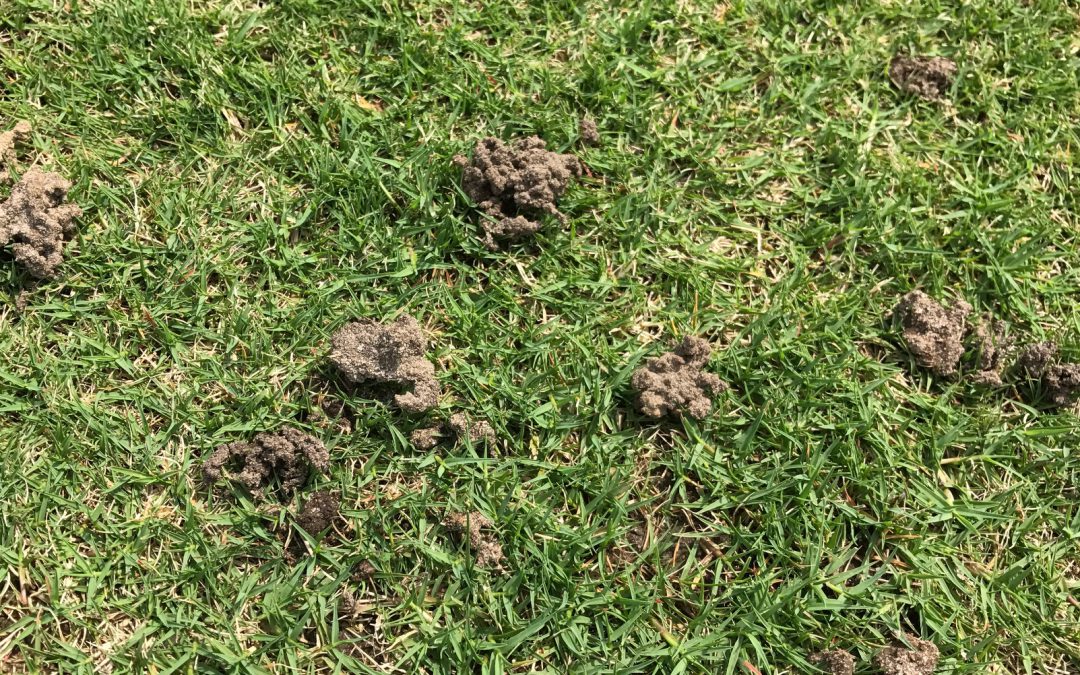
by Mary Salinas | Apr 15, 2021
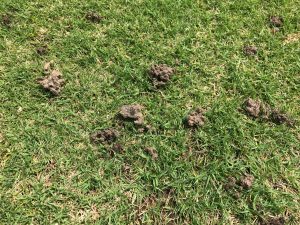
Worm mounds in bermudagrass. Photo credit Mary Salinas, UF IFAS Extension.
The April 8 program of Gardening in the Panhandle LIVE! was focused on turfgrass, quite a popular topic in the springtime as the weather warms and turf comes out of winter dormancy. Here are some of the questions asked of our University of Florida experts and the links to resources they shared.
To start with, two sites that have comprehensive information are Your Florida Lawn: http://hort.ufl.edu/yourfloridalawn/ and Gardening Solutions: https://gardeningsolutions.ifas.ufl.edu/
Turfgrass Selection
Q. What’s the answer to “I want a lawn like I had up north”? Remotely possible?
A. You can have a nice lawn, but it is going to be different in the panhandle. Don’t expect the same grass species or maintenance.
Q. What grass species is recommended for winter overseeding, and when should the grass be sown?
A. Overseeding has its problems and generally not recommended as it shades out the warm season turf as it is coming out of dormancy in the spring. Overseeding Florida Lawns for Winter Color: https://sfyl.ifas.ufl.edu/archive/hot_topics/lawn_and_garden/overseeding_winter_lawns.shtml
Q. How well do new turfgrass varieties thrive against weeds?
A. A healthy and properly maintained lawn is your best defense against weeds and other pests. Additionally, ProVista is a new cultivar of St Augustinegrass that can tolerate glyphosate so it makes it much easier to kill weeds in the lawn. ProVista is not yet widely available in the panhandle.
Q. How do I get a lawn started?
A. Preparing to Plant a Florida Lawn: https://edis.ifas.ufl.edu/lh012
Establishing a Florida Lawn: https://edis.ifas.ufl.edu/topic_lawn_establishment
Q. Can I have a native lawn? What are some recommended alternatives to a turf lawn?
A. Opinions are divided as to whether St. Augustinegrass is native. See these links for lawn Alternatives: https://gardeningsolutions.ifas.ufl.edu/lawns/turf-types/alternatives-to-turfgrass.html
https://gardeningsolutions.ifas.ufl.edu/mastergardener/webinars/mg-update-june2018/ffl-lawn-alternative-mg-update-june-2018-handout.pdf
Fertilizing & Weed Control
Q. How long should I wait before fertilizing new sod?
A. Wait 30-60 days before applying fertilizer. See: Homeowner Best Management Practices for the Home Lawn: https://edis.ifas.ufl.edu/ep236
Q. Basic fertilizer for most lawns if no other information is available.
A. 15-0-15
Q. Are weed and feed products effective? Can you use a Weed & Feed like Scott’s Bonus S this late in the year?
A. Weed and feed products are not recommended.
Weed & Feed, Not Foolproof: https://ocmga.wordpress.com/2013/03/11/weed-and-feed-not-foolproof-by-larry-williams-ufifas-extension-agent/
Weed Management Guide for Florida Lawns: https://edis.ifas.ufl.edu/ep141
Lawn Maintenance & Renovation
Q. My husband overwaters the lawn. Remind everyone about correct watering.
A. Homeowner Best Management Practices for the Home Lawn: https://edis.ifas.ufl.edu/ep236
Watering Your Florida Lawn: https://edis.ifas.ufl.edu/lh025
Sprinkler calibration: https://gardeningsolutions.ifas.ufl.edu/care/irrigation/calibrating-your-irrigation-system.html
Q. What to do about bare spots in St Augustine turf in shade?
A. Rough up the ground and put ½ to 1” compost and let the grass fill in or plant plugs. St. Augustinegrass for Florida Lawns: https://edis.ifas.ufl.edu/lh010
Q. When is the best time to overseed? I have a centipede lawn that’s 15-16 years old and I’m trying to bring it back to health.
A. Be sure to be following good practices and centipedegrass should not fail. Overseeding may not be the best option. Centipedegrass for Florida Lawns: https://edis.ifas.ufl.edu/lh009
Q. How do I repair lawn areas ruined by piled up Hurricane Sally debris?
A. Homeowner Best Management Practices for the Home Lawn: https://edis.ifas.ufl.edu/ep236
Q. How do I care for a zoysiagrass lawn?
A. Zoysiagrass for Florida Lawns: https://edis.ifas.ufl.edu/lh011
Q. Should I mulch or bag clippings?
A. Unless you have disease or weed seeds, mulch the clippings onto the turf so you can return the nutrients and water into the soil. Mowing Your Florida Lawn: https://gardeningsolutions.ifas.ufl.edu/lawns/lawn-care/mowing-your-florida-lawn.html
Pest Management
Q. When is the best time to put out a pre-emergence treatment to control and prevent weeds in your lawn (warm and cool season)?
A. Summer Annual Weed Control Timeline: https://sfyl.ifas.ufl.edu/media/sfylifasufledu/escambia/horticulture/Summer-Annual-Lawn-Weed-Control-Timeline.pdf
Winter Annual Weed Control Timeline: https://sfyl.ifas.ufl.edu/media/sfylifasufledu/escambia/horticulture/Winter-Annual-Lawn-Weed-Control-Timeline.pdf
Q. How do I manage chamberbitter in lawns?
A. Chamberbitter: https://hgic.clemson.edu/factsheet/chamberbitter/
Gallery, with the active ingredient isoxoben, has always been the best product to control chamberbitter. Another product, Gemini, adds prodiamine with isoxoben and also provides good control.
Q. How do you get dollar weed under control?
A. Control irrigation. Dollarweed loves lots of water so make sure you are not overwatering. See: https://edis.ifas.ufl.edu/ep389
Q. I used Image to help control Bahia in Centipede. Anything else that we can use?
A. Metsulfuron methyl, 3 applications every 21 days
Q. Which postemergence herbicide is safe and effective for reducing oxalis in a lawn?
A. Yellow Woodsorrel (Oxalis) Biology and Management in Turf: https://edis.ifas.ufl.edu/ep385
Q. What is the best non-poison weed killer?
A. If a product is a weed killer, whether it is organic or synthetic, it is a poison. Alternatives to Synthetic Herbicides for Container Plants & Homeowner Herbicide Guide: https://edis.ifas.ufl.edu/ep464 & https://edis.ifas.ufl.edu/ep575
Q. How do I treat lawn fungus?
A. First you need to determine which fungus, if any, is responsible. Key to Identification of Landscape Turfgrass Disease: https://edis.ifas.ufl.edu/lh064
Then turn your attention to Turfgrass Disease Management: https://edis.ifas.ufl.edu/lh040
Q. How do I diagnose and control mole crickets?
A. Look at this UF guide: https://edis.ifas.ufl.edu/in1021
This video shows how to do the soap flush to scout for mole crickets https://www.youtube.com/watch?v=sx_o4EMXsCo
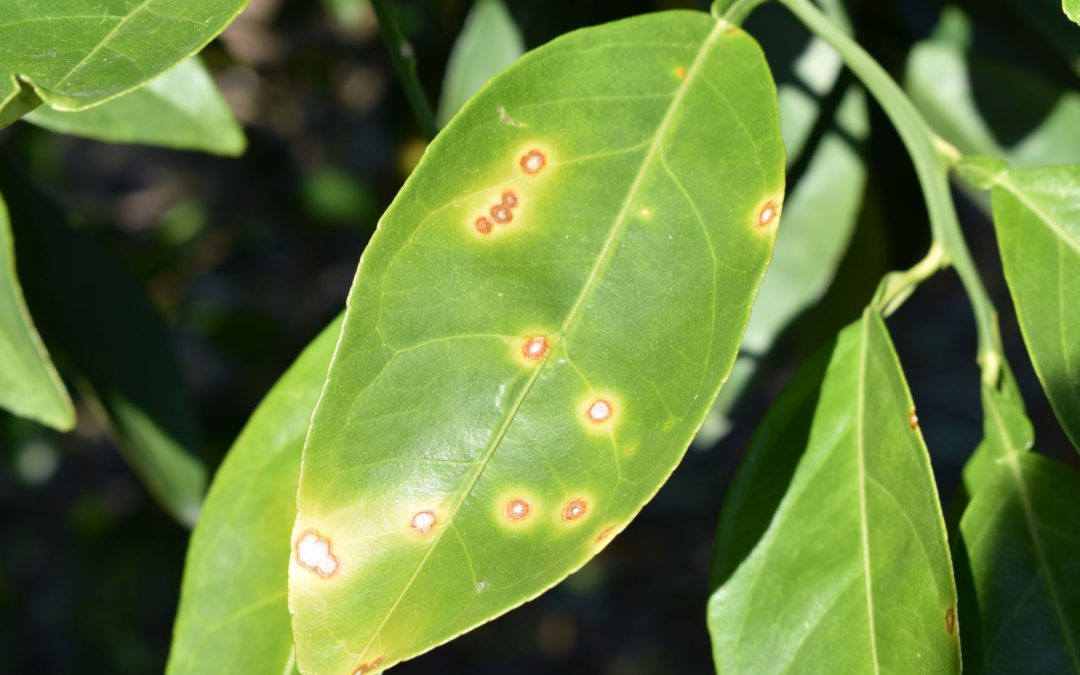
by Mary Salinas | Apr 1, 2021
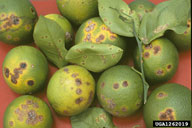
Citrus canker symptoms on twigs, leaves and fruit. Photo by Timothy Schubert, FDACS
Citrus canker was found for the first time in the Florida panhandle in Gulf Breeze in southern Santa Rosa County in November 2013. Since that time, citrus canker has spread widely in the Gulf Breeze area and just recently in 2020 was found in two locations in Panama City and Panama City Beach in Bay County.
Citrus canker is a serious bacterial disease that only infects citrus trees. It will not infect any other plant species nor is it a threat to human health. Severely affected trees experience substantial leaf loss and premature fruit drop and serve as a source for infecting nearby citrus. The disease spreads through wind, rain, and transportation of infected plant material from other locations.
This highly contagious disease has no cure although progression of the disease can be slowed through the use of copper-based products. This publication guides the homeowner on using copper.
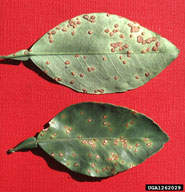
Citrus canker lesions on leaves are raised, rough and visible on both sides of the leaf. Photo by Timothy Shubert, FDACS.
Not all citrus varieties are equally susceptible to this disease. Grapefruit, lemon, and lime are some of the most vulnerable while tangerine and tangelo varieties are among the most resistant.
What should you do if you suspect your citrus is infected with this disease?
- Look at this guide for more information and compare the symptoms on your tree to the photos. Lesions on the leaves penetrate through the leaf so they are visible on the upper and lower leaf surfaces, are rough, and have a yellow halo. The lesions look similar on the fruit and stems. Lesions (or cankers) on the stems usually indicate a longer standing infection of a year or more.
- Consult your local Horticulture Extension Agent to confirm the diagnosis and obtain more information and control/removal strategies.
- Proper removal of infected trees is recommended to prevent the spread of citrus canker but is not mandatory. The best way to dispose of infected trees is through cutting them down and burning them onsite; this ensures than none of the plant material leaves your yard to infect other areas. Consult your local burn regulations before burning. Stray leaves, branches and fruit should be raked and burned or double bagged for the trash. Please avoid disposing of any of your citrus trees by putting them by the side of the road for pickup by the county yard waste recycling or regular waste disposal. The bacterium will survive in the plant tissue and be spread to other neighborhoods in the county. You can, however, double bag infected plant material in sturdy bags and place it in the trash.
For more information please see:
UF IFAS Gardening Solutions: Citrus
Citrus Culture in the Home Landscape
UF IFAS Extension Online Guide to Citrus Diseases
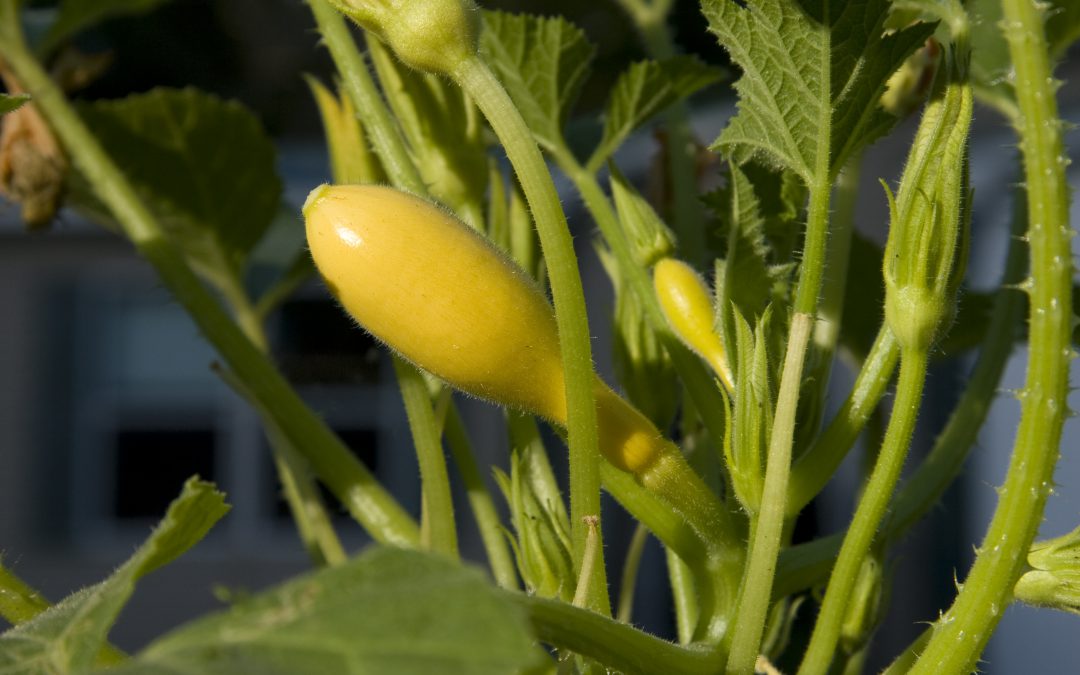
by Mary Salinas | Mar 18, 2021
The weather is warmer and plans and planting for spring vegetable gardens are in full swing. Last week many vegetable gardening topics were addressed in our Gardening in the Panhandle LIVE program. Here are all the links for all the topics we discussed. A recording of last week’s webinar can be found at: https://youtu.be/oJRM3g4lM78
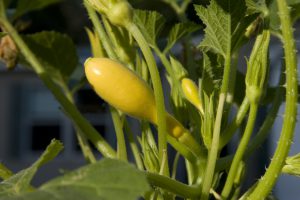
Home grown Squash. Gardening, vegetables. UF/IFAS Photo by Tom Wright.
Getting Started
The place to start is with UF’s ever popular and comprehensive Florida Vegetable Gardening Guide https://edis.ifas.ufl.edu/pdffiles/VH/VH02100.pdf
Many viewers expressed interest in natural methods of raising their crops. Take a look at Organic Vegetable Gardening in Florida https://edis.ifas.ufl.edu/pdffiles/HS/HS121500.pdf
The Square Foot Vegetable Planting Guide for Northwest Florida helps plan the layout of your garden https://sfyl.ifas.ufl.edu/media/sfylifasufledu/leon/docs/pdfs/Vegetable-Square-Foot-Planting-Guide-for-Northwest-Florida-mcj2020.pdf
Maybe you would like the convenience of starting with a fresh clean soil. Gardening in Raised Beds can assist you. https://edis.ifas.ufl.edu/ep472 Also see Gardening Solutions Raised Beds: Benefits and Maintenance https://gardeningsolutions.ifas.ufl.edu/design/types-of-gardens/raised-beds.html
Here is a guide to Fertilizing the Garden https://edis.ifas.ufl.edu/vh025
The Florida Panhandle Planting Guide will help you decide what to plant and when: https://www.facebook.com/SRCExtension/posts/4464210263604274
The Ever-Popular Tomato
To start your journey to the best tomatoes, start with UF/IFAS Gardening Solutions – Tomatoes https://gardeningsolutions.ifas.ufl.edu/plants/edibles/vegetables/tomatoes.html
If you are looking to grow in containers: https://sfyl.ifas.ufl.edu/media/sfylifasufledu/leon/docs/pdfs/Container-Gardening-Spacing-Varieties-UF-IFAS-mcj2020.pdf
Vegetable grafting is gaining in popularity, so if interested, look at this Techniques for Melon Grafting: https://edis.ifas.ufl.edu/hs1257
Blossom end rot occurs when irrigation is irregular and the calcium in the soil does not get carried to the developing fruit. The U-Scout program has a great description of this common problem: https://plantpath.ifas.ufl.edu/u-scout/tomato/blossom-end-rot.html
Our moderators talked about some of their favorite tomato varieties. Josh Freeman is partial to Amelia, a good slicing tomato. Matt Lollar shared some of the best tomato varieties for sauce: Plum/Roma types like BHN 685, Daytona, Mariana, Picus, Supremo and Tachi. For cherry tomatoes, Sheila Dunning recommended Sweet 100 and Juliette.
Whatever variety you choose, Josh says to pick when it starts changing color at the blossom end and bring it indoors to ripen away from pests.
Garden Pest Management
Let’s start with an underground pest. For those of you gardening in the native soil, very tiny roundworms can be a problem. Nematode Management in the Vegetable Garden can get you started: https://edis.ifas.ufl.edu/pdffiles/NG/NG00500.pdf
Leaffooted bugs are quite a nuisance going after the fruit. Here is how to control them: http://extension.msstate.edu/newsletters/bug%E2%80%99s-eye-view/2018/leaffooted-bugs-vol-4-no-24
Cutworms are another frustration. Learn about them here: https://nwdistrict.ifas.ufl.edu/hort/2020/02/27/cutworms-the-moonlit-garden-vandals/
Maybe your tomatoes have gotten eaten up by hornworms. https://gardeningsolutions.ifas.ufl.edu/care/pests-and-diseases/pests/hornworm-caterpillars.html
There are beneficial creatures helping to control the pest insects. Learn to recognize and conserve them and make for a healthier environment. Natural Enemies and Biological Control: https://edis.ifas.ufl.edu/pdffiles/IN/IN12000.pdf
If the beneficials are not numerous enough to control your pests, maybe a natural approach to pest control can help. Natural Products for Managing Landscape and Garden Pests in Florida: https://edis.ifas.ufl.edu/in197
Fungal and bacterial problems can also plague the garden. Go to Integrated Disease Management for Vegetable Crops in Florida for answers: https://edis.ifas.ufl.edu/pdffiles/PP/PP11100.pdf
Get control of weeds early and consult Controlling Weeds by Cultivating & Mulching https://hgic.clemson.edu/factsheet/controlling-weeds-by-cultivating-mulching/
Companion planting is a strategy that has been around for ages and for good reason: https://www.almanac.com/companion-planting-chart-vegetables Some good flowering additions to the garden that Sheila talked about are bee balm, calendula, marigold, nasturtiums, chives, and parsley.
And Some Miscellaneous Topics…
Peppers are another popular crop. Get some questions answered here: https://aggie-horticulture.tamu.edu/archives/parsons/vegetables/pepper.html
When can we plant spinach in Northeast Florida? http://blogs.ifas.ufl.edu/nassauco/2017/07/15/q-can-plant-spinach-northeast-florida/
Figs are a great fruit for northwest Florida. Get started here: https://edis.ifas.ufl.edu/pdffiles/MG/MG21400.pdf and with this https://aggie-horticulture.tamu.edu/extension/homefruit/fig/fig.html
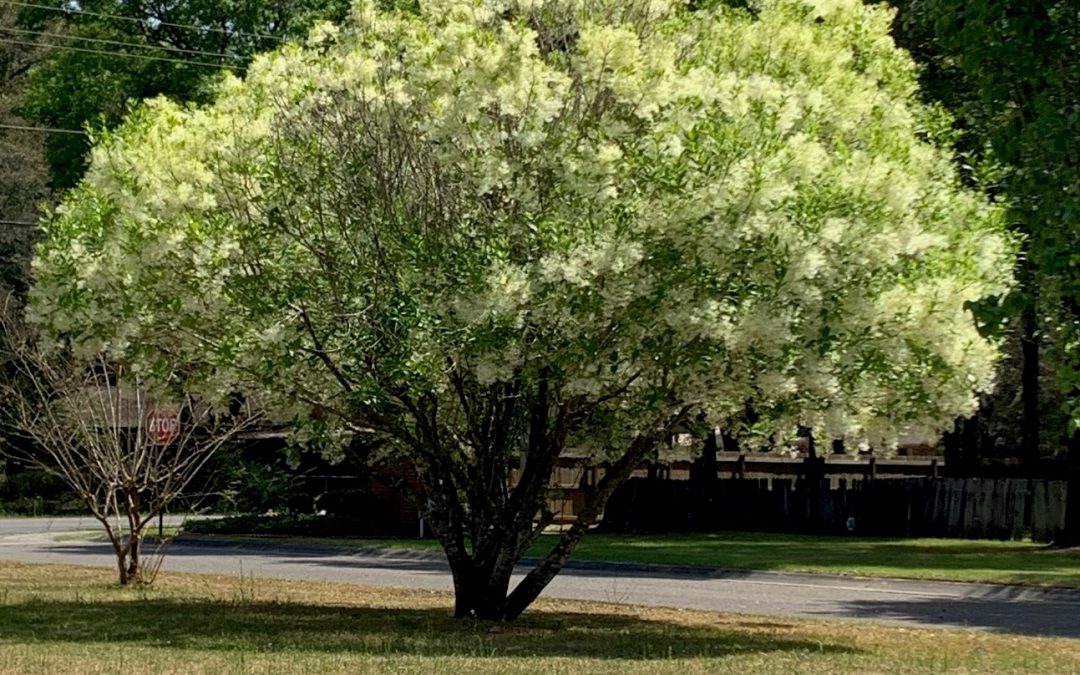
by Mary Salinas | Feb 18, 2021
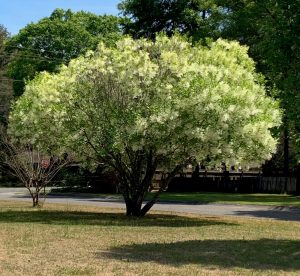
American fringetree Chionanthus virginicus), a native deciduous small tree with delicate blooms in spring. Photo credit: Mary Salinas, UF/IFAS Extension.
January and February are ideal months for adding a tree or two to your landscape in the Florida panhandle. In the cooler weather, the ground stays moist for a longer time, which helps prevent drought stress and the drying out of the rootball. Also, the winds are generally milder, and the tree will have a chance to get established and anchored in before the wilder winds of summer roll in.
Before investing time and money in a tree, take a few minutes and be sure that the species you choose is right for your particular landscape.
Here are some things to consider:
- Whether the area can accommodate the ultimate size of the tree, both height and width, and not grow into overhead wires, streetlights, or your house.
- Are there any underground utilities or septic? A call to 811 can check on where your utilities are.
- The hardiness zone for the tree. Be aware that zone 8 or 9 in the western United States is a different climate with respect to moisture than the same zone 8 or 9 in Florida.
- Whether the tree can thrive in your soil – sandy, loam or clay, loose or compacted, high and dry, or wet and low.
- The amount of sun it requires.
- Whether you want native species that provide food and habitat for native birds and animals.
- Salt-tolerance if located on the coast.
- Wind tolerance, especially if located on the coast. Many fast-growing trees are brittle and susceptible to breakage.
- Whether you prefer an evergreen or deciduous tree. Evergreen trees, like hollies, provide a natural screen all year while some deciduous trees, like maple and bald cypress, provide fall color.
- Is the tree messy, dropping large seed pods, fruit, or leaves?
- The color and shape of leaves and flowers and other ornamental qualities.
- Whether the tree species has known disease or pest issues.

Florida red anise (Illicium floridanum), a small tree/large shrub for shady locations. Photo credit: Mary Salinas UF/IFAS Extension.
Once you choose what species of tree you will add to your landscape, here’s information on Selecting Quality Trees from the Nursery.
Optimum tree health and vigor also depends on the correct methods of Planting and Establishing Trees.
And this site has even more comprehensive information on trees and shrubs: University of Florida/IFAS Landscape Plants.
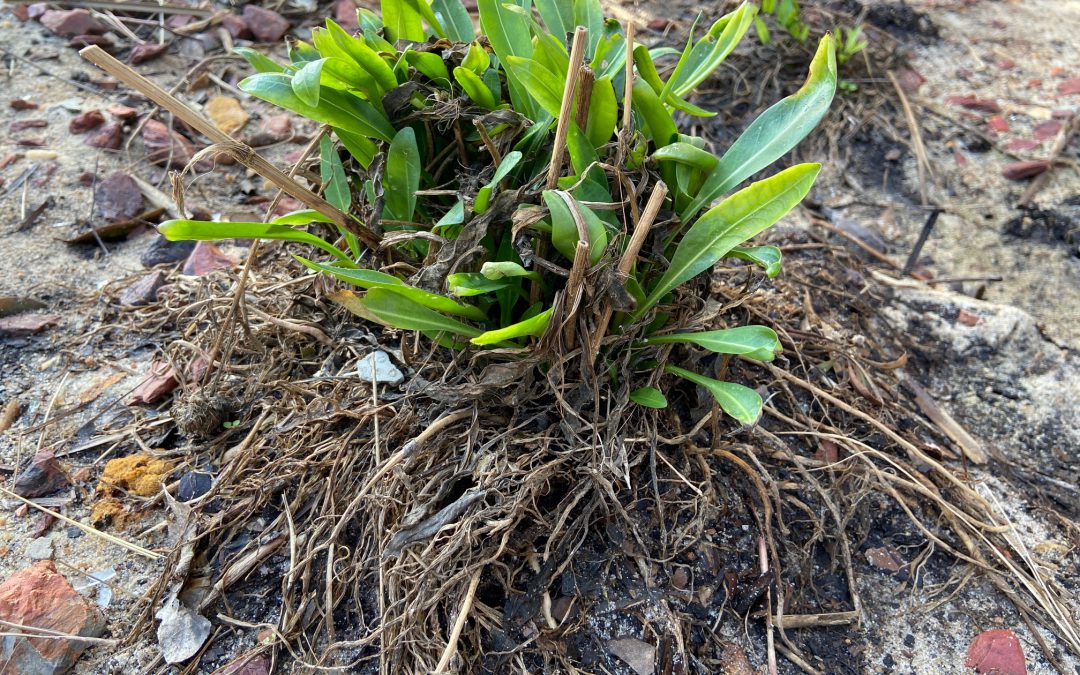
by Mary Salinas | Oct 14, 2020
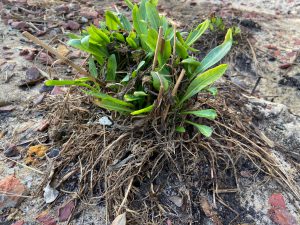
Stoke’s aster ‘Mel’s Blue’ 20 days after Hurricane Sally’s landfall. Notice how soil was washed away from root ball, all the leaves emerged post-hurricane. Photo credit: Mary Salinas, UF/IFAS Extension.
Hurricanes can wreak havoc in your landscape, but they can also reveal what plants are the toughest and most resilient. It’s a great learning opportunity.
A few weeks ago, Hurricane Sally came along and brought about 10 feet of surge and waves across my landscape and completely covered everything except the tallest trees for about 18 hours. (Fortunately, our house is on stilts and we did not have intrusion into our main living areas.)
As expected, the trees, including Dahoon Holly and Sweetbay Magnolia, took a beating but stayed intact. With their dense fibrous root system, most of the clumping native grasses also stayed put.
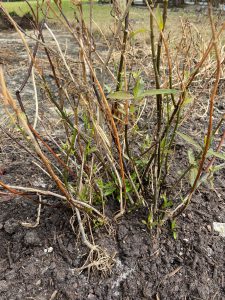
Perennial milkweed 3 weeks post-hurricane. New topsoil and compost now covers the rootball. Photo credit: Mary Salinas, UF/IFAS Extension.
The most surprising plant species that survived were about a dozen Stoke’s aster and 3 perennial milkweed. 4-5 inches of soil all around them was washed away, most of the roots were exposed, and the leaves were stripped or dead. The other perennials that had lived nearby were all washed away. To my surprise, within about 10 days after the storm, these two plant species started poking up new stems and leaves.
Here’s a list of some of the plants either in my yard or in the neighborhood that survived Hurricane Sally’s storm surge and may be suitable to add to your coastal landscape:
- Dahoon holly, Ilex cassine
- Muhly grass, Muhlenbergia capillaris
- Dwarf Fakahatchee grass, Tripsacum floridanum
- Perennial milkweed, Asclepias perennis
- Stoke’s aster, Stokesia laevis, specifically the cultivars ‘Mel’s Blue’ and ‘Divinity’
- Bottlebrush, Callistemon citrinus
- Gardenia, Gardenia jasminoides
- Bougainvillea, Bougainvillea spp.
- Flax Lily, Dianella tasmanica
- Crapemyrtle, Lagerstroemia spp.
- Cabbage palm, Sabal palmetto
- Canary Island date palm, Phoenix canariensis
- Sweetbay magnolia, Magnolia virginiana
- Augustinegrass, Stenotaphrum secundatum
- And, unfortunately, the rhizomes of the invasive torpedograss also survived.
For more information on salt tolerant and hurricane resistant plants, see:
UF/IFAS Gardening Solutions: Coastal Landscapes
UF/IFAS Gardening Solutions: Salt-tolerant Lawngrasses
UF/IFAS Gardening Solutions: Trees That Can Withstand Hurricanes













